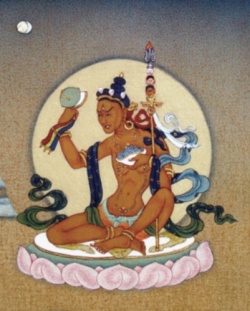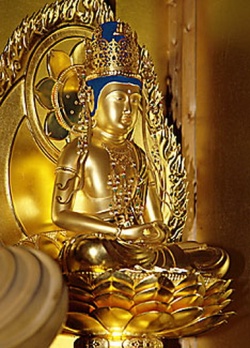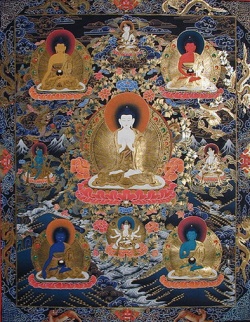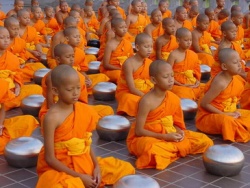Difference between revisions of "What is a Monk?"
(Created page with "thumb|250px| <poem> If the ancient, classical sources are right, in his mid-twenties the Buddha renounced the life of pleasure and affluence. He cut off his ...") |
|||
| (5 intermediate revisions by the same user not shown) | |||
| Line 1: | Line 1: | ||
[[File:-007.jpg|thumb|250px|]] | [[File:-007.jpg|thumb|250px|]] | ||
| + | <nomobile>{{DisplayImages|315|516|3620|3920|133}}</nomobile> | ||
| + | |||
| + | |||
| + | |||
<poem> | <poem> | ||
| − | If the ancient, classical sources are right, in his mid-twenties the Buddha renounced the life of pleasure and affluence. He cut off his hair, became an ascetic, and entered the forest, where he lived with other men – śramaṇas – who were engaged in the practice of austerities and meditation. After six year of practicing a severe form of asceticism that included rigorous fasting, the Buddha realized that this type of discipline was as much of an extreme as the life he had renounced. He took nourishment, and regaining his bodily strength, he meditated until he attained enlightenment. Shortly after his enlightenment, the texts tell us, the Buddha established an order of monks, and eventually an order of nuns. Applying the lessons he had learned in the earlier periods of his life, he created over his lifetime a discipline – the Vinaya – that would come to govern the life of the Buddhist clergy: a discipline that the Buddha considered a middle way between the extremes of sensual indulgence and self-mortification. | + | If the [[ancient]], classical sources are right, in his mid-twenties the [[Buddha]] renounced the [[life]] of [[pleasure]] and affluence. |
| + | |||
| + | He cut off his [[hair]], became an [[ascetic]], and entered the {{Wiki|forest}}, where he lived with other men – [[śramaṇas]] – who were engaged in the [[practice of austerities]] and [[meditation]]. | ||
| + | |||
| + | After six year of practicing a severe [[form]] of [[asceticism]] that included rigorous [[fasting]], the [[Buddha]] [[realized]] that this type of [[discipline]] was as much of an extreme as the [[life]] he had renounced. | ||
| + | |||
| + | He took [[nourishment]], and regaining his [[bodily]] strength, he [[meditated]] until he [[attained]] [[enlightenment]]. Shortly after his [[enlightenment]], the texts tell us, the [[Buddha]] established an [[order of monks]], and eventually an [[order of nuns]]. | ||
| + | |||
| + | Applying the lessons he had learned in the earlier periods of his [[life]], he created over his [[lifetime]] a [[discipline]] – the [[Vinaya]] – that would come to govern the [[life]] of the [[Buddhist]] {{Wiki|clergy}}: a [[discipline]] that the [[Buddha]] considered a [[middle way]] between the extremes of {{Wiki|sensual}} {{Wiki|indulgence}} and [[self-mortification]]. | ||
| − | Motivated by a sense of disgust with the conditioned world and its sufferings, and by the realization that no lasting happiness is to be found in worldly pleasures, Buddhist monks and nuns are those individuals who emulate the Buddha by abandoning the life of sensual enjoyment. In place of a life dedicated to the pursuit of pleasure, they give themselves over to a life of discipline and restraint, realizing that this is conducive (some Buddhist schools would say necessary) to achieving a more lasting happiness, the permanent peace of nirvana. Disgust with the world, or renunciation (ngenjung) – an attitude that Tsongkhapa likens to the attitude of prisoners who can think of nothing else but release from their incarceration – is, strictly speaking, a necessary condition for entering the monastic life. In practice, however, few individuals probably entered monasteries with an already developed and mature sense of renunciation. | + | |
| + | |||
| + | Motivated by a [[sense]] of {{Wiki|disgust}} with the [[conditioned world]] and its [[sufferings]], and by the [[realization]] that no lasting [[happiness]] is to be found in [[worldly]] [[pleasures]], [[Buddhist monks]] and [[nuns]] are those {{Wiki|individuals}} who emulate the [[Buddha]] by [[abandoning]] the [[life]] of {{Wiki|sensual}} [[enjoyment]]. | ||
| + | |||
| + | In place of a [[life]] dedicated to the pursuit of [[pleasure]], they give themselves over to a [[life]] of [[discipline]] and {{Wiki|restraint}}, [[realizing]] that this is conducive (some [[Buddhist]] schools would say necessary) to achieving a more lasting [[happiness]], the [[permanent]] [[peace]] of [[nirvana]]. | ||
| + | |||
| + | Disgust with the [[world]], or [[renunciation]] ([[ngenjung]]) – an [[attitude]] that [[Tsongkhapa]] likens to the [[attitude]] of prisoners who can think of nothing else but [[release]] from their incarceration – is, strictly {{Wiki|speaking}}, a necessary [[condition]] for entering the [[monastic]] [[life]]. | ||
| + | |||
| + | In practice, however, few {{Wiki|individuals}} probably entered [[monasteries]] with an already developed and mature [[sense]] of [[renunciation]]. | ||
[[File:-lent-.jpg|thumb|250px|]] | [[File:-lent-.jpg|thumb|250px|]] | ||
| − | |||
| − | Formally speaking, a monk or nun is any individual who has taken monastic vows in a Buddhist ordination ceremony.2 Practically speaking, in Tibetan culture, a monk is any male3 with one of three forms of ordination: | + | In [[Tibet]], most [[monks]] were [[ordained]] at an early age before they were even instructed in [[religious]] {{Wiki|principles}}. They entered the [[monastery]] with an [[attitude]] that was probably more akin to that of children about to attend summer camp. |
| + | |||
| + | Many of these children probably had little deeply felt [[devotion]] to the [[religious]] [[life]], at least initially. | ||
| + | |||
| + | They entered the [[monastery]] simply because this was the wish of their [[parents]]. | ||
| + | |||
| + | Those few who made such a choice at a more mature age may have entered for [[religious]] [[reasons]], but as often as not they may have entered simply to escape the responsibilities that came with [[traditional]] [[family]] [[life]]. | ||
| + | |||
| + | It is not surprising that young men should have sought [[monasticism]] as a [[lifestyle]], or that [[parents]] should have wanted such a [[life]] for their sons. | ||
| + | |||
| + | In [[Tibet]], a [[monk’s]] [[life]] was financially more secure than that of the typical villager, it afforded one a greater opportunity for [[education]], and it sometimes opened the door to civil service positions in the [[Tibetan]] government.1 | ||
| + | |||
| + | As in most [[Buddhist]] countries, [[monasticism]] in [[Tibet]] became institutionalized, and the [[monastic]] [[life]] was for many a profession. | ||
| + | |||
| + | This does not mean that some [[monks]] did not go on to develop a profound [[sense]] of [[religious]] vocation, and even a deeply felt [[sense]] of [[renunciation]], over the period of their [[lives]]. | ||
| + | |||
| + | The historical records clearly show that the [[monasteries]] produced great [[saints]], {{Wiki|individuals}} who saw the [[world]] and its [[activities]] as vanities, but these were always in the minority, and even in these cases, such an [[attitude]] was something that developed and grew over a [[lifetime]]. | ||
| + | |||
| + | Formally {{Wiki|speaking}}, a [[monk]] or [[nun]] is any {{Wiki|individual}} who has taken [[monastic vows]] in a [[Buddhist ordination]] ceremony.2 Practically {{Wiki|speaking}}, in [[Tibetan culture]], a [[monk]] is any male3 with one of three [[forms]] of [[ordination]]: | ||
| + | |||
| − | |||
| − | + | renunciate ([[rapjung]]) | |
| − | full ordination (gelong). | + | {{Wiki|novice}} ([[getsül]]) |
| + | |||
| + | full [[ordination]] ([[gelong]]). | ||
[[File:00x200as.jpg|thumb|250px|]] | [[File:00x200as.jpg|thumb|250px|]] | ||
| − | |||
| − | + | ||
| + | |||
| + | Renunciates take the five basic [[vows]] of a layman,5 supplemented by a few additional [[vows]] that require them to adopt certain [[monastic]] behaviors: for example, shaving their heads and wearing [[robes]]. | ||
| + | |||
| + | Novices take [[ten vows]] (sometimes further elaborated in a list of thirty-six).6 | ||
| + | |||
| + | Fully [[ordained]] [[monks]] in the [[Tibetan tradition]] take 253 vows.7 | ||
| + | |||
| + | All [[forms]] of [[monastic]] [[ordination]] in [[Tibet]] are presumed to be for [[life]], even if there [[exist]] mechanisms that allow [[monks and nuns]] to return their [[vows]] – and hence to return to lay [[life]] – if they so choose.8 | ||
| + | |||
| + | A young boy can take [[novice ordination]] when he is old enough to successfully “scare away [[crows]]” (about age seven). | ||
| + | |||
| + | To take full [[ordination]], one must be at least twenty years of age. The higher levels of [[ordination]] require the lower levels as prerequisites. | ||
| + | |||
| + | Hence, one must take {{Wiki|novice}} [[vows]] before taking full [[ordination]], and one must take lay [[vows]] before taking {{Wiki|novice}} (although all of the [[ordinations]] can take place within a single day). | ||
| + | |||
| + | Any official member of [[Sera]] is required to have one of these three [[forms]] of [[ordination]]: renunciate, {{Wiki|novice}}, or full. | ||
| + | |||
| + | Typically, young boys take renunciate [[ordination]] when they first enter the [[monastery]] (either [[Sera]] or the [[monastery]] in their home region). | ||
| + | |||
| + | They may remain at this level of [[ordination]] for several years until their [[teacher]] decides that they are ready to take {{Wiki|novice}} [[vows]]. | ||
| + | |||
| + | Since [[textualists]] who planned to complete their studies and to obtain the ''[[geshé]]'' [[degree]] had to study the [[Vinaya]], and since the study of the [[Vinaya]] required that the [[monk]] have full [[ordination]], all serious [[textualists]] eventually received full [[ordination]]. | ||
| + | |||
| + | There were some [[monks]], however, who remained novices their whole [[lives]]. Obviously, these were mostly workers (and not [[textualists]]). | ||
| + | |||
| + | {{Wiki|Novice}} and full [[ordination]] {{Wiki|ceremonies}} would usually take place en [[masse]] from time to time, and the great [[scholars]] and [[highest]] [[lamas]] of the [[monastery]] (or of the [[Geluk tradition]]) usually served as the [[abbot]] ([[khenpo]])9 on these occasions. | ||
[[File:65.jpg|thumb|250px|]] | [[File:65.jpg|thumb|250px|]] | ||
| − | [1] Since the time of the Fifth Dalai Lama, the Tibetan governmental bureaucracy had two branches that worked jointly. One was manned by non-monk aristocrats, and the other by monks who were awarded these positions largely on the basis of merit. | + | |
| − | [2] For a description of such a ceremony, | + | [1] Since the time of the [[Fifth Dalai Lama]], the [[Tibetan]] governmental {{Wiki|bureaucracy}} had two branches that worked jointly. One was manned by non-monk {{Wiki|aristocrats}}, and the other by [[monks]] who were awarded these positions largely on the basis of [[merit]] |
| − | [3] There are also female monastics in the Tibetan tradition, called nuns (ani). In India there existed different levels of female monastic ordination, from the ordination of novices to full ordination (gelongma). It has traditionally been thought that the lineage of full ordination for women was lost in India before it could be passed on to Tibetans. Recently, however, Kurtis Schaeffer has claimed that there are passages in some Tibetan historical texts that point to the existence of fully ordained nuns in Tibet | + | . |
| − | [4] In a more general sense, the term rapjung refers to any monk or nun who has taken the vows of novice or above; that is, it is simply another name for the clergy. While it is not clear that rapjungas a monastic status different from novice and fully ordained is recognized formally in the Vinaya, it does seem to be one that was recognized in Tibetan Buddhist monasteries. See, for example, Geshe Sopa, Lectures on Tibetan Religious Culture, vol. 1 (Dharamsala, India: Library of Tibetan Works & Archives, 1983), 4: “It is permissible for (a young boy) not to take the vows of a novice or a fully ordained monk right away. Even if he does not take vows, he can become a monk (raptujung) by changing his clothes (for | + | [2] For a description of such a {{Wiki|ceremony}}, |
| − | [5] These are the upāsaka (Tib. genyen) vows: not lying, not killing, not stealing, not engaging in sexual misconduct, and not taking intoxicants. | + | |
| − | [6] For a list of the vows taken by novices in the Tibetan tradition, | + | [3] There are also {{Wiki|female}} [[monastics]] in the [[Tibetan tradition]], called [[nuns]] ([[ani]]). |
| − | [7] This number varies from one Buddhist tradition to the next, and so the traditions do differ, but only on minor points. For example, in the Theravāda Buddhist Vinaya, practiced in most of Southeast Asia, fully ordained monks take 227 vows. Tibetan Buddhists follow the Mūlasarvāstivāda Vinaya, where the vows number 253. For the list of vows in Theravāda Buddhism (preserved in a text called the Patimokkha), | + | |
| − | [8] This, however, is generally looked down upon. Monks who leave the monkhood are called dralok. The first part of this compound, dra simply means monk. The word lok has two meanings: a verbal one (“to return, to turn away from”), and a nominal one (“a mistake”). The word dralok carries both connotations of the word lok. The ex-monk has not only turned away from monasticism, he has also committed an error. Far from being neutral, then, the word carries a negative connotation. | + | In [[India]] there existed different levels of [[female monastic]] [[ordination]], from the [[ordination]] of novices to full [[ordination]] ([[gelongma]]). |
| − | [9] In the context of the Vinaya, the abbot is the chief monk in charge of the ordination ceremony. Only later did the term come to be used to designate the head of a monastery. In some schools of Tibetan Buddhism, the term is also used to designate a rank of scholar, but this is an even more recent usage. | + | |
| + | It has [[traditionally]] been [[thought]] that the [[lineage]] of full [[ordination]] for women was lost in [[India]] before it could be passed on to [[Tibetans]]. | ||
| + | |||
| + | Recently, however, [[Kurtis Schaeffer]] has claimed that there are passages in some [[Tibetan]] historical texts that point to the [[existence]] of [[fully ordained]] [[nuns]] in [[Tibet]] . | ||
| + | |||
| + | Be that as it may, there is no [[lineage]] of full [[ordination]] for women in [[Tibetan Buddhism]] today. There are discussions under way, however, concerning the reintroduction of full [[monastic]] [[ordination]] for women in [[Tibetan Buddhism]]. | ||
| + | |||
| + | |||
| + | [4] In a more general [[sense]], the term [[rapjung]] refers to any [[monk]] or [[nun]] who has taken the [[vows]] of {{Wiki|novice}} or above; that is, it is simply another [[name]] for the {{Wiki|clergy}}. | ||
| + | |||
| + | While it is not clear that [[rapjungas]] a [[monastic]] {{Wiki|status}} different from {{Wiki|novice}} and [[fully ordained]] is [[recognized]] formally in the [[Vinaya]], it does seem to be one that was [[recognized]] in [[Tibetan Buddhist monasteries]]. | ||
| + | |||
| + | See, for example, [[Geshe Sopa]], Lectures on [[Tibetan]] [[Religious]] {{Wiki|Culture}}, vol. 1 ({{Wiki|Dharamsala}}, [[India]]: | ||
| + | |||
| + | Library of [[Tibetan]] Works & Archives, 1983), 4: “It is permissible for (a young boy) not to take the [[vows]] of a {{Wiki|novice}} or a [[fully ordained monk]] right away. | ||
| + | |||
| + | Even if he does not take [[vows]], he can become a [[monk]] ([[raptujung]]) by changing his [[clothes]] (for [[monks]]’ [[robes]]) and shaving his [[hair]]” ([[gnas]] skabs [[dge tshul]] dang [[dge slong gi sdom pa]] ma blangs [[kyang]] ’grigs/ de dus [[sdom pa]] ma blangs [[kyang]] gos [[bsgyur ba dang/ skra bregs pa [[sogs byas te [[rab tu byung]]). | ||
| + | |||
| + | [5] These are the [[upāsaka]] (Tib. [[genyen]]) [[vows]]: not {{Wiki|lying}}, not {{Wiki|killing}}, not [[stealing]], not engaging in [[sexual misconduct]], and not taking [[intoxicants]]. | ||
| + | |||
| + | |||
| + | |||
| + | [6] For a list of the [[vows]] taken by novices in the [[Tibetan tradition]], | ||
| + | |||
| + | [7] This number varies from one [[Buddhist tradition]] to the next, and so the [[traditions]] do differ, but only on minor points. | ||
| + | |||
| + | For example, in the [[Theravāda]] [[Buddhist Vinaya]], practiced in most of {{Wiki|Southeast Asia}}, [[fully ordained]] [[monks]] take 227 [[vows]]. | ||
| + | |||
| + | [[Tibetan Buddhists]] follow the [[Mūlasarvāstivāda Vinaya]], where the [[vows]] number 253. For the list of [[vows]] in [[Theravāda Buddhism]] (preserved in a text called the [[Patimokkha]]), | ||
| + | |||
| + | [8] This, however, is generally looked down upon. [[Monks]] who leave the [[monkhood]] are called [[dralok]]. The first part of this compound,'' [[dra]]'' simply means [[monk]]. | ||
| + | |||
| + | The [[word]] lok has two meanings: a [[verbal]] one (“to return, to turn away from”), and a nominal one (“a mistake”). | ||
| + | |||
| + | The [[word]] '''[[dralok]]''' carries both connotations of the [[word]] ''[[lok]]''. The ex-monk has not only turned away from [[monasticism]], he has also committed an error. Far from being [[neutral]], then, the [[word]] carries a negative connotation. | ||
| + | |||
| + | [9] In the context of the [[Vinaya]], the [[abbot]] is the chief [[monk]] in charge of the [[ordination]] {{Wiki|ceremony}}. Only later did the term come to be used to designate the head of a [[monastery]]. In some [[schools of Tibetan Buddhism]], the term is also used to designate a rank of [[scholar]], but this is an even more recent usage. | ||
</poem> | </poem> | ||
{{R}} | {{R}} | ||
[http://www.thlib.org/#!essay=/cabezon/sera/people/monks/s/b1 www.thlib.org] | [http://www.thlib.org/#!essay=/cabezon/sera/people/monks/s/b1 www.thlib.org] | ||
| − | [[Category: Monks ]] | + | [[Category:Monks]] |
| + | [[Category:Tibetan Buddhist monk's]] | ||
Latest revision as of 20:17, 4 August 2022
If the ancient, classical sources are right, in his mid-twenties the Buddha renounced the life of pleasure and affluence.
He cut off his hair, became an ascetic, and entered the forest, where he lived with other men – śramaṇas – who were engaged in the practice of austerities and meditation.
After six year of practicing a severe form of asceticism that included rigorous fasting, the Buddha realized that this type of discipline was as much of an extreme as the life he had renounced.
He took nourishment, and regaining his bodily strength, he meditated until he attained enlightenment. Shortly after his enlightenment, the texts tell us, the Buddha established an order of monks, and eventually an order of nuns.
Applying the lessons he had learned in the earlier periods of his life, he created over his lifetime a discipline – the Vinaya – that would come to govern the life of the Buddhist clergy: a discipline that the Buddha considered a middle way between the extremes of sensual indulgence and self-mortification.
Motivated by a sense of disgust with the conditioned world and its sufferings, and by the realization that no lasting happiness is to be found in worldly pleasures, Buddhist monks and nuns are those individuals who emulate the Buddha by abandoning the life of sensual enjoyment.
In place of a life dedicated to the pursuit of pleasure, they give themselves over to a life of discipline and restraint, realizing that this is conducive (some Buddhist schools would say necessary) to achieving a more lasting happiness, the permanent peace of nirvana.
Disgust with the world, or renunciation (ngenjung) – an attitude that Tsongkhapa likens to the attitude of prisoners who can think of nothing else but release from their incarceration – is, strictly speaking, a necessary condition for entering the monastic life.
In practice, however, few individuals probably entered monasteries with an already developed and mature sense of renunciation.
In Tibet, most monks were ordained at an early age before they were even instructed in religious principles. They entered the monastery with an attitude that was probably more akin to that of children about to attend summer camp.
Many of these children probably had little deeply felt devotion to the religious life, at least initially.
They entered the monastery simply because this was the wish of their parents.
Those few who made such a choice at a more mature age may have entered for religious reasons, but as often as not they may have entered simply to escape the responsibilities that came with traditional family life.
It is not surprising that young men should have sought monasticism as a lifestyle, or that parents should have wanted such a life for their sons.
In Tibet, a monk’s life was financially more secure than that of the typical villager, it afforded one a greater opportunity for education, and it sometimes opened the door to civil service positions in the Tibetan government.1
As in most Buddhist countries, monasticism in Tibet became institutionalized, and the monastic life was for many a profession.
This does not mean that some monks did not go on to develop a profound sense of religious vocation, and even a deeply felt sense of renunciation, over the period of their lives.
The historical records clearly show that the monasteries produced great saints, individuals who saw the world and its activities as vanities, but these were always in the minority, and even in these cases, such an attitude was something that developed and grew over a lifetime.
Formally speaking, a monk or nun is any individual who has taken monastic vows in a Buddhist ordination ceremony.2 Practically speaking, in Tibetan culture, a monk is any male3 with one of three forms of ordination:
renunciate (rapjung)
novice (getsül)
full ordination (gelong).
Renunciates take the five basic vows of a layman,5 supplemented by a few additional vows that require them to adopt certain monastic behaviors: for example, shaving their heads and wearing robes.
Novices take ten vows (sometimes further elaborated in a list of thirty-six).6
Fully ordained monks in the Tibetan tradition take 253 vows.7
All forms of monastic ordination in Tibet are presumed to be for life, even if there exist mechanisms that allow monks and nuns to return their vows – and hence to return to lay life – if they so choose.8
A young boy can take novice ordination when he is old enough to successfully “scare away crows” (about age seven).
To take full ordination, one must be at least twenty years of age. The higher levels of ordination require the lower levels as prerequisites.
Hence, one must take novice vows before taking full ordination, and one must take lay vows before taking novice (although all of the ordinations can take place within a single day).
Any official member of Sera is required to have one of these three forms of ordination: renunciate, novice, or full.
Typically, young boys take renunciate ordination when they first enter the monastery (either Sera or the monastery in their home region).
They may remain at this level of ordination for several years until their teacher decides that they are ready to take novice vows.
Since textualists who planned to complete their studies and to obtain the geshé degree had to study the Vinaya, and since the study of the Vinaya required that the monk have full ordination, all serious textualists eventually received full ordination.
There were some monks, however, who remained novices their whole lives. Obviously, these were mostly workers (and not textualists).
Novice and full ordination ceremonies would usually take place en masse from time to time, and the great scholars and highest lamas of the monastery (or of the Geluk tradition) usually served as the abbot (khenpo)9 on these occasions.
[1] Since the time of the Fifth Dalai Lama, the Tibetan governmental bureaucracy had two branches that worked jointly. One was manned by non-monk aristocrats, and the other by monks who were awarded these positions largely on the basis of merit
.
[2] For a description of such a ceremony,
[3] There are also female monastics in the Tibetan tradition, called nuns (ani).
In India there existed different levels of female monastic ordination, from the ordination of novices to full ordination (gelongma).
It has traditionally been thought that the lineage of full ordination for women was lost in India before it could be passed on to Tibetans.
Recently, however, Kurtis Schaeffer has claimed that there are passages in some Tibetan historical texts that point to the existence of fully ordained nuns in Tibet .
Be that as it may, there is no lineage of full ordination for women in Tibetan Buddhism today. There are discussions under way, however, concerning the reintroduction of full monastic ordination for women in Tibetan Buddhism.
[4] In a more general sense, the term rapjung refers to any monk or nun who has taken the vows of novice or above; that is, it is simply another name for the clergy.
While it is not clear that rapjungas a monastic status different from novice and fully ordained is recognized formally in the Vinaya, it does seem to be one that was recognized in Tibetan Buddhist monasteries.
See, for example, Geshe Sopa, Lectures on Tibetan Religious Culture, vol. 1 (Dharamsala, India:
Library of Tibetan Works & Archives, 1983), 4: “It is permissible for (a young boy) not to take the vows of a novice or a fully ordained monk right away.
Even if he does not take vows, he can become a monk (raptujung) by changing his clothes (for monks’ robes) and shaving his hair” (gnas skabs dge tshul dang dge slong gi sdom pa ma blangs kyang ’grigs/ de dus sdom pa ma blangs kyang gos [[bsgyur ba dang/ skra bregs pa [[sogs byas te rab tu byung).
[5] These are the upāsaka (Tib. genyen) vows: not lying, not killing, not stealing, not engaging in sexual misconduct, and not taking intoxicants.
[6] For a list of the vows taken by novices in the Tibetan tradition,
[7] This number varies from one Buddhist tradition to the next, and so the traditions do differ, but only on minor points.
For example, in the Theravāda Buddhist Vinaya, practiced in most of Southeast Asia, fully ordained monks take 227 vows.
Tibetan Buddhists follow the Mūlasarvāstivāda Vinaya, where the vows number 253. For the list of vows in Theravāda Buddhism (preserved in a text called the Patimokkha),
[8] This, however, is generally looked down upon. Monks who leave the monkhood are called dralok. The first part of this compound, dra simply means monk.
The word lok has two meanings: a verbal one (“to return, to turn away from”), and a nominal one (“a mistake”).
The word dralok carries both connotations of the word lok. The ex-monk has not only turned away from monasticism, he has also committed an error. Far from being neutral, then, the word carries a negative connotation.
[9] In the context of the Vinaya, the abbot is the chief monk in charge of the ordination ceremony. Only later did the term come to be used to designate the head of a monastery. In some schools of Tibetan Buddhism, the term is also used to designate a rank of scholar, but this is an even more recent usage.








